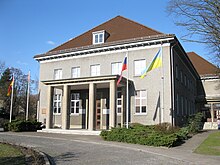Fortress Pioneer School
The fortress pioneer school (also Pionierschule 1 ) established in 1936 in Berlin-Karlshorst was a central training facility for the pioneer troops of the German Wehrmacht , the headquarters of the Soviet military administration in Germany and the headquarters of the Soviet secret service KGB in the GDR . Today the site is mainly used for residential purposes; the German-Russian Museum is located in the former officers' mess .
Building description
The entire area is protected as a historical monument , as it is one of the last bases originally built for the Wehrmacht, which has largely been preserved unchanged to this day.
The facility is dominated by the former lecture hall building. Four smaller houses, originally intended to accommodate the course participants and as the headquarters of the school commandant's office, the commander's residence, the officers' house and the porter's building complete the ensemble. The facades are designed in a neoclassical style.
Building history
In 1936 the school was opened east of the center of Karlshorst. On the night of May 8th to 9th, 1945 , the unconditional surrender of the Wehrmacht was signed in the officers' mess , where the headquarters of the 5th Shock Army of the Red Army was located during the Battle of Berlin . The buildings then served as the headquarters of the Soviet Military Administration in Germany (SMAD) until 1949 and later, until the troops were withdrawn in 1994, as the world's largest headquarters of the KGB outside the Soviet Union. In the following years they stood empty.
In 1998 a development plan procedure began, which should turn the barracks and other surrounding land, a total of around 40 hectares, into living space for federal employees in particular. However, it soon turned out that the demand from this group of users was low, so that the project was never implemented. There were several changes to the plan and political disputes between the Federal Republic as the owner, the Berlin Senate Administration and the monument protection authority. During this time the condition of the historical buildings deteriorated considerably. The status of the development plan from 2008, which was finally implemented, provided for a garden city with mixed house types of single-family, semi-detached and terraced houses as well as perimeter block development and villas, as well as complete retention of the old barracks.
Also in 2008, the Federal Agency for Real Estate Tasks offered the actual, around 12.5 hectare barracks site for sale. The project development company "Projekt Rentenvorsorge GmbH", which has repeatedly used similar former military facilities, acquired the property for just under 3.5 million euros.
From the beginning of 2010, building applications for the modernization of individual buildings were gradually submitted. At the same time, the pre-sale of the apartments began, primarily to investors, but around ten percent also to owner-occupiers. After the individual buildings had been fully marketed, construction work began.
Despite the neglected impression, the building fabric and above all the massive steel stone ceilings of the floors turned out to be well preserved. A total of ten buildings were modernized, three new houses built and the outdoor area redesigned. One of the most obvious changes to the lecture hall building was the furnishing of each furnished apartment with a balcony, loggia or terrace, which originally did not exist. The roof has been renewed, reinforced and, unlike the original, provided with additional windows. Inside, in addition to the complete renovation of the building services, the installation of an elevator in the lecture hall building was a decisive change. In contrast to many other conversion projects, the room layout, apart from the large lecture halls, remained largely unchanged. This also applies to the access via long corridors, which is unusual today. However, maisonette apartments were built on three floors on the top floor and in the roof.
The construction work for the entire facility was completed in the third quarter of 2014. 342 apartments were built in the old buildings, 27 in the three new houses. The living space adds up to around 27,000 square meters, the individual units are between 45 and 184 square meters in size. The renovation costs of the listed buildings amounted to around 29 million euros. The apartments were marketed under the name "Wohnpark Karlshorst".
Web links
literature
- Federal Institute for Building, Urban and Spatial Research (Ed.): Conversion of non-residential buildings into residential properties - Documentation of the case studies, 2015, PDF version
Coordinates: 52 ° 29 ′ 16.2 ″ N , 13 ° 32 ′ 24.6 ″ E

